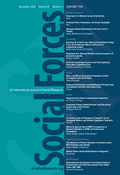-
Views
-
Cite
Cite
David S. Pedulla, The Hidden Costs of Contingency: Employers' Use of Contingent Workers and Standard Employees' Outcomes, Social Forces, Volume 92, Issue 2, December 2013, Pages 691–722, https://doi.org/10.1093/sf/sot081
Close - Share Icon Share
Abstract
The rise of contingent employment relations has been one of the most profound shifts in the US economy over the past forty years. While recent scholarship has begun to examine the consequences of organizations' use of contingent workers for the full-time, standard employees in those workplaces, important limitations remain in this line of research. First, much of the research in this area relies on small, nonrandom samples of organizations and data that are decades old. Second, limited attention has been paid to the mechanisms through which the use of contingent workers shapes standard employees' attitudes and outcomes. Finally, the varied consequences of using different types of contingent workers have been underdeveloped in the literature. In this article, we address these limitations of existing research, contributing insights about the differential consequences of how organizations obtain flexibility as well as the nature of job insecurity in the “new economy.”



